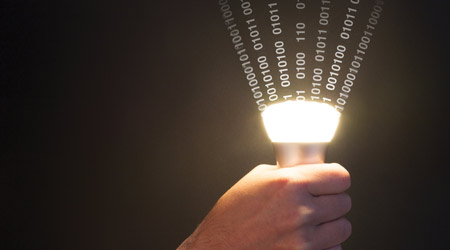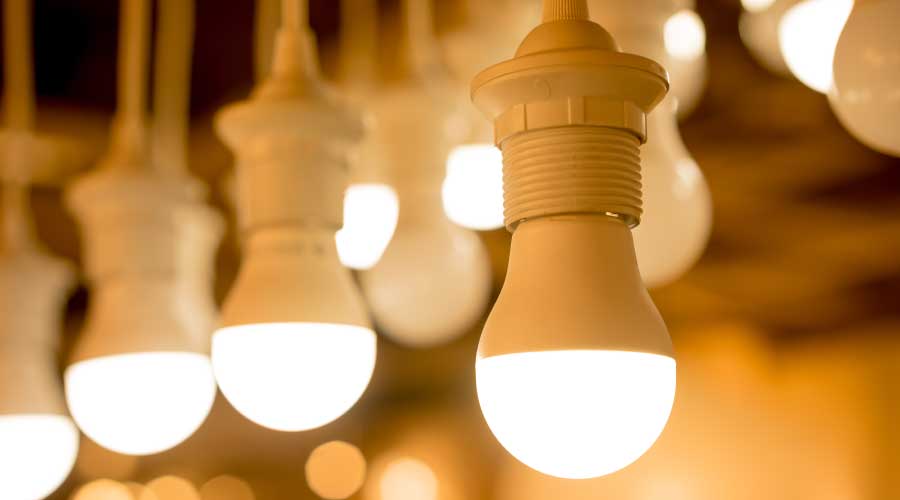Internet of Things Brings New Paradigm of Connection for Lighting Controls Systems
High-performance lighting controls systems are aided by new technologies that offer flexibility, function, and energy savings.
In recent years, there has been explosive growth in the development of lighting control systems. Previous generations of lighting controls and control systems provided basic low-level functionality for a building’s light fixtures. For example, low-voltage relay panels automatically turn on fixtures according to a schedule. Most relay panels can also take input from occupancy sensors and even from photosensors, but typically they can only switch fixtures on and off based on that input.
In addition to this limitation, previous generations of lighting control systems (and even some new types of systems) are “circuit-based”— meaning that zones are established based on physical circuitry. The new paradigm for lighting control systems is to use individual controllers in every single fixture. Many systems also rely on using fixture-mounted sensors (occupancy sensors and photosensors, and in some cases others such as temperature sensors, etc.). As such, logical “zoning” of fixtures, or for that matter rezoning, is accomplished in the software without regard for physical circuitry, providing much more flexibility.
This new paradigm is essentially a Building Internet of Things model. The only question is to what are these “things” connected? The easiest approach for a controls vendor is to develop a “closed” system where these “things” are connected to a dedicated server. They may use either open or proprietary communication protocols and programming to provide the desired functionality, but they do not talk to and work directly with other systems. More recently, many lighting control system vendors have chosen to embrace interoperability by allowing for communication with larger building networks. In many cases, these systems offer the option to link to other systems such as a BMS using BACnet or other open protocol.
BACnet rising
According to one expert at a leading lighting controls vendor, “BACnet has grown into the de facto standard for integrating building systems. It allows for the convenient machine-to-machine (M2M) transfer of data between building systems.“ He gives an example of an occupancy sensor that is built into the lighting fixture in a room; it can tell an HVAC system to close a damper when the room is vacant. Beyond M2M, it also allows more user-friendly human-to-machine (H2M) interactions. Facility managers can be presented a unified interface for all building systems, rather than having to deal with disparate interfaces provided by an assortment of vendors. Use of a VPN, or other secure means of accessing the building network, permits a facility manager to monitor and make changes to the building systems from anywhere in the world.
Energy efficiency has been one of the strongest selling points of a networked lighting control system deployed with maximum granularity (one controller or sensor per fixture, etc.). For example, if every fixture has its own built-in occupancy sensor, it’s possible that more fixtures may dim or turn off throughout the course of the day. Networked lighting control systems are typically only installed when they drive dimmable fixtures. This can substantially facilitate greater energy savings. For example, fixtures can be “tuned” (dimmed) to a lower default level that is still acceptable to occupants. Photosensors can signal the control system to dim fixtures where there is adequate influx of daylight. Individual occupants can even dim fixtures if such control is provided and authorized. Lastly, “demand response” strategies can be implemented by effecting incremental reductions in lighting energy use as opposed to turning off entire circuits, which occupants would probably not accept.
Variety of lighting controls benefits
Studies have shown that substantial energy savings have indeed resulted from using advanced, networked lighting control systems — especially when care is taken to properly commission the system and train staff on its use. However, there are a variety of additional benefits that a networked lighting control system can potentially garner for an owner beyond just saving energy. For example:
• Asset tracking
• Space utilization and indoor positioning
• Diagnosing and reporting
• Conference room scheduling
• Security
• Energy tracking
• Integration with BMS/HVAC
Many of these benefits are made possible by systems employing maximum granularity of sensors and controllability (each fixture having its own “controller” and sensor(s)).
A lot of recent research in the lighting industry has centered around the subject of light and health. In particular, a growing body of research suggests that there may be distinct benefits to providing specific light levels as well as coloration of light at different times of the day (termed “circadian stimulus” by the Lighting Research Center in Troy, NY).
If fixtures contain LEDs that produce different colors of light, some control systems can be programmed to “tune” the coloration of the light output as well as dim or increase the amount of light emanating from the fixtures. Recent studies have shown what seems to be a direct correlation between specific coloration and light levels and an increase in productivity, comfort, alertness, well-being, etc. What owner/employer wouldn’t want to take advantage of a tool that could help make employees more productive and more comfortable? At certain times, this may require a decrease in light levels and a change in coloration.
However, at other times during the day, it may require an increase of light over typical levels. For this and other reasons, an advanced, networked control system can provide the flexibility to change light levels in either direction — up or down. This is a new paradigm. The more traditional approach is reducing energy use to a bare minimum at the outset, knowing that you can never increase light output from that point onward. If light levels and the resulting power draw are typically kept to a minimum, why does it matter if your system can allow for higher levels of light if and when they are needed?
Related Topics:













